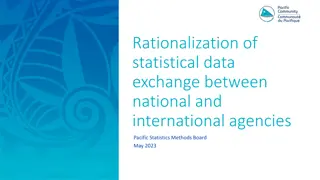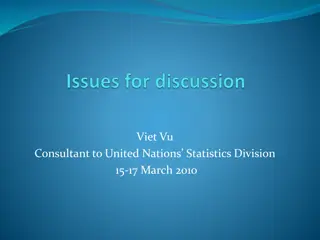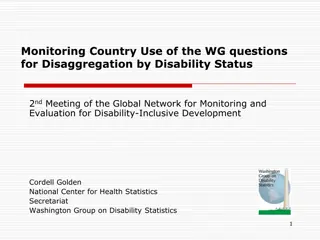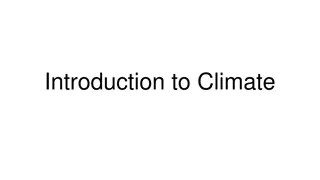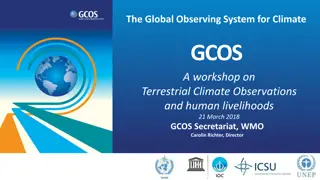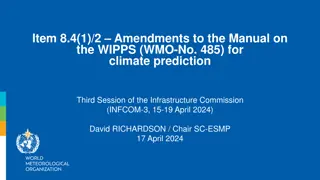Development of Guidance on the Role of NSOs in Achieving National Climate Objectives
The Task Force on the Role of NSOs in Achieving National Climate Objectives, led by Malgorzata Cwiek from the United Nations Economic Commission for Europe, aims to provide guidance for National Statistical Offices on contributing to national climate goals. With active members from various countries and organizations, the task force focuses on showcasing how NSOs can support climate action through data production, standardization, knowledge sharing, and more. The timeline includes progress reviews and consultations for finalizing the draft report by April 2024.
Download Presentation

Please find below an Image/Link to download the presentation.
The content on the website is provided AS IS for your information and personal use only. It may not be sold, licensed, or shared on other websites without obtaining consent from the author. Download presentation by click this link. If you encounter any issues during the download, it is possible that the publisher has removed the file from their server.
E N D
Presentation Transcript
UNECE Task Force UNECE Task Force on the Role of NSOs in on the Role of NSOs in Achieving National Climate Achieving National Climate Objectives Objectives Malgorzata Cwiek Statistical Division United Nations Economic Commission for Europe 9th Joint OECD/UNECE Seminar on the Implementation of SEEA 20 March 2024
Background UNECE work on climate change-related statistics UNSC programme review on CC and official statistics 2009 CES Task Force on climate change related-statistics 2011 2012 2013 CES recommendations on CCRS 2014 2015 2016 UNECE Expert Fora for Producers and Users of Climate Change- Related Statistics 2017 CES initial indicator set 2018 2019 CES refined set of indicators and an in-depth review 2020 2021 New Task Force on the Role of NSOs 2022 2
Background Members, objective and timeline of the Task Force Objective Develop guidance on how NSOs can contribute to achieving national climate objectives identify concrete ways in which NSOs can be involved and showcase what the statistical system already offers to support climate action. The Guidance is meant to inspire and support people working in NSOs who want to start working on climate change-related statistics or want to do more. Active Members ( 30) NSOs: Netherlands (Chair), Armenia, Azerbaijan, Belarus, Canada, Costa Rica, Denmark, Ireland, Italy, Poland, Serbia, Spain, T rkiye, United Kingdom, Ukraine Ministry of Environment / GHG inventory: Armenia, Belarus, Poland, Costa Rica IOs: ECLAC, ESCAP, ECA, ECB, EEA, Eurostat, IMF, IEA, PARIS21, UNFCCC, UNSD, UNEP Timeline February 2022 start of the work August 2022 and 2023 progress review by the Expert Forum February 2024 approval of the draft report by the CES Bureau April 2024 broad consultation with all CES member countries and international organizations 3
Background Guiding principles for the work Target audience Primary audience:NSOs who start or develop their work in this area Document may also be useful to data users to inform about what NSOs can offer and international organizations The Guidance is meant to Showcase how NSOs can contribute through, e.g.: producing data and indicators, helping standardize data produced by others, building up data inventories, coordinating within the statistical office and with other agencies and ministries, knowledge sharing, and improving the accessibility and use of data for informing the public Build on existing resources and materials Define the main questions about the role of NSOs, identify differences and similarities between countries, and the main challenges Provide a portfolio of real country examples, including statistical activities and products, collaborations, institutional arrangements etc. Not: Reinvent the wheel, develop new indicators, classifications or frameworks
Guidance on the Role of NSOs in Achieving National Climate Objectives 1. 2. 3. 4. 5. 6. 7. 8. 9. 10. Conclusions/recommendations and future work Introduction Institutional landscape and the role of NSOs Reporting under the Paris Agreement Statistics for climate change mitigation policymaking Statistics for climate change adaptation policymaking Statistics for just transition policymaking Informing the public Climate finance and financial aspects of climate action Guidance on cross-cutting issues Each chapter from 3 to 8 examines policy context, definitions and data needs and identifies how NSOs can contribute
Chapter 1: Institutional landscape and role of NSOs Role of NSOs, statistical frameworks and indicator sets Frameworks NSOs Are the main part of national statistical systems and produce official statistics on key topics for the economy and society Have the mandate for and expertise on data collection, safeguarding, processing and dissemination Are professionally independent providers of data for public good in line with the Fundamental Principles of Official Statistics Framework for Development of Environment Statistics System of Environmental-Economic Accounting International Recommendations for Energy Statistics Disaster-Related Statistics Framework And: IPCC Guidelines for National GHG Inventories Indicator sets CES Set of Core Climate Change-Related Statistics and Indicators Global Set of Climate Change Statistics and Indicators CES Set of Core Disaster-Risk-Related Indicators Sendai Framework indicators SDG Global Indicator Framework
Chapter 1: Institutional landscape and role of NSOs Roles in producing statistics and data
Chapter 1: Institutional landscape and role of NSOs Examples of actors by main stakeholder group
Chapter 5: Statistics for climate change adaptation policymaking Concepts and definitions related to CC adaptation Understanding the key terms Adaptation: in human systems, ( ) the process of adjustment to actual or expected climate and its effects, in order to moderate harm or exploit beneficial opportunities , where the potential for adverse consequences (risk) results from interaction between climate-related hazards with the exposure and vulnerability of the affected human or ecological system (IPCC AR6) + successful adaptation vs. maladaptation Hazard: The potential occurrence of a natural or human-induced physical event or trend that may cause loss of life, injury or other health impacts, as well as damage and loss to property, infrastructure, livelihoods, service provision, ecosystems and environmental resources. Exposure: The presence of people; livelihoods; species or ecosystems; environmental functions, services, and resources; infrastructure; or economic, social, or cultural assets in places and settings that could be adversely affected. Vulnerability: The propensity or predisposition to be adversely affected. Vulnerability encompasses a variety of concepts and elements, including sensitivity or susceptibility to harm and lack of capacity to cope and adapt. And relationships between them
Chapter 5: Statistics for climate change adaptation policymaking Concepts and definitions related to CC adaptation
Chapter 5: Statistics for climate change adaptation policymaking Policy context National Adaptation Planning (NAP) and Implementation Process NAP process enables countries to assess vulnerabilities, mainstream CC risks and address adaptation and can be used to understand the scope of information needed for effective adaptation policymaking Explaining the Adaptation Policy Cycle: Assessing impacts, vulnerability, risks and resilience Planning for adaptation Implementing adaptation measures Monitoring & evaluation Did you know? Technical guidelines for the national adaptation plan process (2012) highlight that a data plan for the NAP M&E should be developed and supported with adequate resources and data should be collected and stored in a systematic manner. The responsibility for compilation and aggregation of data collected from multiple agencies should be clearly assigned to one agency, which could be the NSO.
Chapter 5: Statistics for climate change adaptation policymaking Policy context Challenges in implementing and assessing adaptation Insufficient institutional arrangements, lack of knowledge and capacity, unreliable and outdated data and information, lack of existing policy, lack of resources Did you know? The UNFCCC Adaptation Committee s 2022 Synthesis report for the technical assessment component of the first global stocktake specifically mentions gaps in socioeconomic data, especially collocated with climate observations as one of challenges in adaptation, which could inhibit a more accurate identification of climate risks and the attribution of observed changes to either climate impacts or socioeconomic developments. It also notes the following potential opportunities for enhanced action, support and international cooperation: Enhancing open access to existing climate and socioeconomic data, Exploiting the potential of, among others, national statistical systems, and Establishing international arrangements for the coordination of socioeconomic data collection and management, e.g. new adaptation-relevant official statistics
Chapter 5: Statistics for climate change adaptation policymaking How NSOs can contribute? Roles Identifying the current role and coordinating with other organizations Identifying and producing relevant statistics and indicators by statistical domain: Demographic and social statistics, health statistics, economic statistics, agriculture statistics, energy statistics, environment statistics, hazardous events and disasters, System of Environmental-Economic Accounting Linking data from different sources or domains Subnational focus and geospatially enabled statistical data Sharing data and microdata for research and risk analyses Playing a role in adaptation monitoring and evaluation Promoting harmonization and international comparability through use of existing classifications and indicators Linking work already done by NSOs (based on collected examples) with policy questions in the context of meeting information needs related to climate change adaptation
Data is integral to the implementation of the Paris Agreement How can the statistical community contribute to climate action? Enabling new research Enhanced Transparency Framework and Global Stocktake Possible involvement in GHG inventories, NDC tracking reporting on adaptation from providing source data to active collaboration Improving availability of internationally comparable data to facilitate both ETF and Global Stocktake GLOBALLY Mitigation Adaptation Just transition NATIONALLY AND Monitoring energy transition and other activities Monitoring enablers for transition like infrastructure, green jobs and perceptions Data on populations, infrastructure and ecosystemswhich are vulnerable or exposed to risk Localized, granular data Impact of policies by populations groups, gender, regions, e.g. energy poverty Linking environmental with social and economic data LOCALLY
Data is integral to the implementation of the Paris Agreement How can the statistical community contribute to climate action? Informing the public Making statistics and data easy to access and use dedicated portals, explanations for users with various levels of expertise, various dissemination formats, e.g. for analysts, journalists, students, bloggers Building trust and public awareness through transparent, reliable and relevant data NATIONALLY AND LOCALLY Financial aspects of climate action Coordination, cooperation and standardization Government expenditures, subsidies and transfers Supporting national climate finance reporting Climate impacts of economic/financial activities Data for assessing physical and transition risks Measuring climate investment
Role of national statistical offices in achieving national climate objectives Cross-cutting issues Collaboration with researchers and academia Governance and coordination Engagement with policymakers Local and geospatially enabled data Perceptions, attitudes and behaviours Strengthening data collection Conclusions, recommendations and further work Conclusions Recommendations Climate change is a big societal issue NSOs have a strong basis for supporting work and already a lot to contribute Statistical system needs to catch up with the climate community Establishing collaborations, sharing the work, leveraging the expertise Get engaged with the climate community Start with existing statistics and data Cooperation and capacity building Governance and procedures Content and development of new information Further work: building relations, supporting new reporting, work on new topics, promotion of the Guidance
Key resources Key resources Pages of the past Expert Fora 2012-2023 Climate Change-Related Statistics in Practice 2023 (August 2023) Climate Change-Related Statistics in Practice 2022 (September 2022) Climate Change-Related Statistics in Practice 2021 (August 2021) CES Set of Core Climate Change-Related Indicators and Statistics Using SEEA (August 2021) Reporting on climate data and information under the Paris Agreement: A potential opportunity for national statistical offices to get involved (UNFCCC, June 2021) In-depth review on the role of the statistical community in climate action (February 2020) Road maps to improve climate change-related statistics Word Russian (March 2017) Leaflet summarizing the CES Recommendations also in Russian (October 2016) CES Recommendations on Climate Change-related Statistics (December 2014) All the resources available on the web 17
Collecting good practices Climate Change-Related Statistics in Practice 2021-2023 Link to the document Link to the document Link to the document
Thank you! Malgorzata Cwiek cwiek@un.org 20 March 2024





